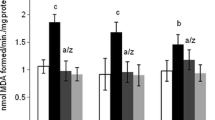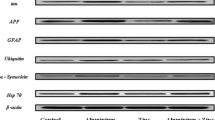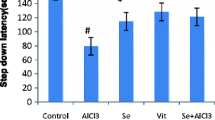Abstract
This study was carried out to investigate the effects of lithium (Li) supplementation on aluminium (Al) induced changes in antioxidant defence system and histoarchitecture of cerebrum and cerebellum in rats. Al was administered in the form of aluminium chloride (100 mg/kg b.wt./day, orally) and Li was given in the form of Li carbonate through diet (1.1 g/kg diet, daily) for a period of 2 months. Al treatment significantly enhanced the levels of lipid peroxidation and reactive oxygen species in both the cerebrum and cerebellum, which however were decreased following Li supplementation. The enzyme activities of catalase, superoxide dismutase (SOD) and glutathione reductase (GR) were significantly increased in both the regions following Al treatment. Li administration to Al-fed rats decreased the SOD, catalase and GR enzyme activities in both the regions; however, in cerebellum the enzyme activities were decreased in comparison to normal controls also. Further, the specific activity of glutathione-s-transferase and the levels of total and oxidized glutathione were significantly decreased in cerebrum and cerebellum following Al treatment, which however showed elevation upon Li supplementation. The levels of reduced glutathione were significantly decreased in cerebrum but increased in cerebellum following Al treatment, which however were normalized upon Li supplementation but in cerebellum only. Apart from the biochemical changes, disorganization in the layers of cerebrum and vacuolar spaces were also observed following Al treatment indicating the structural damage. Similarly, the loss of purkinje cells was also evident in cerebellum. Li supplementation resulted in an appreciable improvement in the histoarchitecture of both the regions. Therefore, the study shows that Li has a potential to exhibit neuroprotective role in conditions of Al-induced oxidative stress and be explored further to be treated as a promising drug against neurotoxicity.








Similar content being viewed by others
References
Adler AJ, Caruso C, Berlyne GM (1995) The effect of aluminum on the vanadium-mediated oxidation of NADH. Nephron 69(1):34–40
Aghdam Y, Barger S, Steven W (2007) Glycogen synthase kinase-3 in neurodegeneration and neuroprotection lessons from lithium. Curr Alzheimer Res 4(1):21–31. doi:10.2174/156720507779939832
Albendea CD, Gómez-Trullén EM, Fuentes-Broto L, Miana-Mena FJ, Millán-Plano S, Reyes-Gonzales MC, Martínez-Ballarín E, García JJ (2007) Melatonin reduces lipid and protein oxidative damage in synaptosomes due to aluminium. J Trace Elem Med Biol 21(4):261–268. doi:10.1016/j.jtemb.2007.04.002
Barr RJ, Alpern KS, Jay S (1993) Histiocytic reaction associated with topical aluminum chloride (Drysol reaction). J Dermatol Surg Oncol 19:1017–1021
Basu S, Das Gupta R, Chaudhuri AN (2000) Aluminium related changes in brain histology: protection by calcium and nifedipine. Indian J Exp Biol 38(9):948–950
Benzi G, Marzatico F, Pastoris O, Villa RF (1989) Relationship between aging, drug treatment and the cerebral enzymatic antioxidant system. Neurosci Res 24:137–148. doi:10.1002/jnr.490240203
Bondy SC, Kirstein S (1996) The promotion of iron-induced generation of reactive oxygen species in nerve tissue by aluminium. Mol Chem Neuropathol 27:185–194
Bondy SC, Ali SF, Guo-Ross S (1998a) Aluminium but not iron treatment induced pro-oxidant events in the rat brain. Mol Chem Neuropathol 34:219–232. doi:10.1007/BF02815081
Bondy SC, Guo-Ross SX, Pien J (1998b) Mechanisms underlying the aluminum-induced potentiation of the pro-oxidant properties of transition metals. Neurotoxicology 19(1):65–71
Buchta M, Kiesswetter E, Otto A, Schaller KH, Seeber A, Hilla W, Windorfer K, Stork J, Kuhlmann A, Gefeller O, Letzel S (2003) Longitudinal study examining the neurotoxicity of occupational exposure to aluminium-containing welding fumes. Int Arch Occup Environ Health 76(7):539–548. doi:10.1007/s00420-003-0450-9
Carlberg I, Mannervik B (1985) Glutathione reductase. Methods Enzymol 113:484–490. doi:10.1016/S0076-6879(85)13062-4
Clarke DD, Sokoloff L (1999) Circulation and energy metabolism of the brain. In: Siegel GJ , Agranoff BW, Albers RW, Fisher SK, Uhler MD (eds) Basic neurochemistry: molecular, cellular and medical aspects. Lippincott-Raven, Philadelphia, pp 637–669
Colomina MT, Roig JL, Torrente M, Vicens P, Domingo JL (2005) Concurrent exposure to aluminum and stress during pregnancy in rats: effects on postnatal development and behavior of the offspring. Neurotoxicol Teratol 27(4):565–574. doi:10.1016/j.ntt.2005.06.014
Cucarella C, Montoliu C, Hermenegildo C, Sáez R, Manzo L, Miñana MD, Felipo V (1998) Chronic exposure to aluminum impairs neuronal glutamate-nitric oxide-cyclic GMP pathway. J Neurochem 70(4):1609–1614
Dringen R, Gutterer JM, Harrlinger J (2000) Glutathione metabolism in the brain. Eur J Biochem 267:4912–4916. doi:10.1046/j.1432-1327.2000.01597.x
Driver AS, Kodavanti PR, Mundy WR (2000) Age-related changes in reactive oxygen species production in rat brain homogenates. Neurotoxicol Teratol 22(2):175–181. doi:10.1016/S0892-0362(99)00069-0
Dua R, Gill KD (2001) Aluminium phosphide exposure: implications on rat brain lipid peroxidation and antioxidant defence system. Pharmacol Toxicol 89(6):315–319. doi:10.1034/j.1600-0773.2001.d01-167.x
Ellman GL (1959) Tissue sulfhydryl groups. Arch Biochem Biophys 82:70. doi:10.1016/0003-9861(59)90090-6
Esparza JL, Gómez M, Rosa Nogués M, Paternain JL, Mallol J, Domingo JL (2005) Melatonin reduces oxidative stress and increases gene expression in the cerebral cortex and cerebellum of aluminum-exposed rats. J Pineal Res 39(2):129–136
Exley C (2004) The pro-oxidant activity of aluminium. Free Radic Biol Med 36(3):380–387. doi:10.1016/j.freeradbiomed.2003.11.017
Frey BN, Valvassori SS, Réus GZ, Martins MR, Petronilho FC, Bardini K, Dal-Pizzol F, Kapczinski F, Quevedo J (2006) Effects of lithium and valproate on amphetamineinduced oxidative stress generation in an animal model of mania. J Psychiatry Neurosci 31(5):326–332
Gerlach M, Ben-Sachar D, Riederer P, Youdin MBH (1994) Altered brain metabolism of iron as a cause of neurodegenerative diseases? J Neurochem 63:793–807
Gupta A, Shukla GS (1995) Effect of chronic aluminum exposure on the levels of conjugated dienes and enzymatic antioxidants in hippocampus and whole brain of rat. Bull Environ Contam Toxicol 55(5):716–722
Habig WH, Pabst MJ, Jacoby WB (1974) Glutathione-S-transferase: the first enzymatic step in mercapturic acid formation. J Biol Chem 249:7130–7139
Halliwell B (2006) Oxidative stress and neurodegeneration: where are we now? J Neurochem 97(6):1634–1658. doi:10.1111/j.1471-4159.2006.03907.x
Hiroi T, Wei H, Hough C, Leeds P, Chuang DM (2005) Protracted lithium treatment protects against the ER stress elicited by thapsigargin in rat PC12 cells: roles of intracellular calcium, GRP78 and Bcl-2. Pharmacogenomics J 5:102–111. doi:10.1038/sj.tpj.6500296
Hu H, Yang YJ, Li XP, Chen GH (2005) Effect of aluminum chloride on motor activity and species-typical behaviors in mice. Zhonghua Lao Dong Wei Sheng Zhi Ye Bing Za Zhi 23(2):132–135
Humanson GL (1961) Basic procedure—animal tissue technique. Part I. W. H. Freeman and Company, San. Francisco, pp 130–132
Ittel TH (1993) Determinants of gastrointestinal absorption and distribution of aluminium in health and uraemia. Nephrol Dial Transplant 8(1):17–24
Jyoti A, Sethi P, Sharma D (2007) Bacopa monniera prevents from aluminium neurotoxicity in the cerebral cortex of rat brain. J Ethnophramacol 111:56–62. doi:10.1016/j.jep.2006.10.037
Kaiser RR, Correa MC, Spanevello RM, Morsch VM, Mazzanti CM, Goncalves JF, Schetinger MRC (2005) Acetylcholinesterase activation and enhanced lipid peroxidation after long-term exposure to low levels of aluminium on different mouse brain regions. J Inorg Biochem 99:1865–1870. doi:10.1016/j.jinorgbio.2005.06.015
Kaneko N, Sugioka T, Sakurai H (2007) Aluminum compounds enhance lipid peroxidation in liposomes: insight into cellular damage caused by oxidative stress. J Inorg Biochem 101(6):967–975. doi:10.1016/j.jinorgbio.2007.03.005
Kong S, Liochev S, Fridovich I (1992) Aluminum(III) facilitates the oxidation of NADH by the superoxide anion. Free Radic Biol Med 13(1):79–81. doi:10.1016/0891-5849(92)90168-G
Kono Y (1978) Generation of superoxide radicals during auto oxidation of hydroxylamine and an assay for superoxide dismutase. Arch Biochem Biophys 186:189. doi:10.1016/0003-9861(78)90479-4
Lowry OH, Rosebrough NJ, Farr AL, Randall RJ (1951) Protein measurement with the Folin Phenol reagent. J Biol Chem 193:265
Luck H (1971) Catalase. In: Bergmeyer HU (ed) Methods of enzymatic analysis. Academic Press, New York, pp 885–893
Meister A, Tate SS (1976) Glutathione and related Ý-glutamyl compounds: biosynthesis and utilization. Annu Rev Biochem 45:559–604. doi:10.1146/annurev.bi.45.070176.003015
Nehru B, Bhalla P (2006) Reversal of an aluminium induced alteration in redox status in different regions of rat brain by administration of centrophenoxine. Mol Cell Biol 290:185–191
Nehru B, Bhalla P, Garg A (2007) Further evidence of centrophenoxine mediated protection in aluminium exposed rats by biochemical and light microscopy analysis. Food Chem Toxicol 45(12):2499–2505. doi:10.1016/j.fct.2007.05.026
Pearse AGE (1968) In: Histochemistry, theoretical and applied, vol 1, 3rd edn. Churchill Livingstone, London, p 660
Reddy PH (2006) Amyloid precursor protein-mediated free radicals and oxidative damage: implications for the development and progression of Alzheimer’s disease. J Neurochem 96(1):1–13. doi:10.1111/j.1471-4159.2005.03530.x
Roberts E (1986) Alzheimer’s disease may begin in the nose and may be caused by aluminosilicates. Neurobiol Aging 7(6):561–567. doi:10.1016/0197-4580(86)90119-3
Schafer M, Goodenough S, Moosmann B, Behl C (2004) Inhibition of glycogen synthase kinase 3 beta is involved in the resistance to oxidative stress in neuronal HT22 cells. Brain Res 1005:84–89. doi:10.1016/j.brainres.2004.01.037
Schulz JB, Lindenau J, Seyfried J, Dichgans J (2000) Glutathione, oxidative stress and neurodegeneration. Eur J Biochem 267:4909–4911. doi:10.1046/j.1432-1327.2000.01595.x
Shao L, Young LT, Wang JF (2005) Chronic treatment with mood stabilizers lithium and valproate prevents excitotoxicity by inhibiting oxidative stress in rat cerebral cortical cells. Biol Psychiatry 58:879–884. doi:10.1016/j.biopsych.2005.04.052
Spencer JP, Jenner P, Daniel SE, Lees AJ, Marsden DC, Halliwell B (1998) Conjugates of catecholamines with cysteine and GSH in Parkinson’s disease: possible mechanisms of formation involving reactive oxygen species. J Neurochem 71:2112–2122
Strange RC, Jones PW, Freyr AA (2000) Glutathione-s-transferase: genetics and role in toxicology. Toxicol Lett 112–113:357–363. doi:10.1016/S0378-4274(99)00230-1
Tandon A, Dhawan DK, Nagpaul JP (1998) Effect of lithium on hepatic lipid peroxidation and antioxidative enzymes under different dietary protein regimens. J Appl Toxicol 18:187–190. doi:10.1002/(SICI)1099-1263(199805/06)18:3<187::AID-JAT495>3.0.CO;2-Y
Tandon A, Bhalla P, Nagpaul JP, Dhawan DK (2006) Effect of lithium on rat cerebrum under different dietary protein regimens. Drug Chem Toxicol 29:333–344. doi:10.1080/01480540600820122
Wang JF, Young LT (2004) Regulation of molecular chaperone GRP78 by mood stabilizing drugs. Clin Neurosci Res 4:281–288. doi:10.1016/j.cnr.2004.09.007
Wang JF, Shao L, Sun X (2004) Glutathione-S-transferase is a novel target for mood stabilizing drugs in primary cultured neurons. J Neurochem 88:1477–1484. doi:10.1046/j.1471-4159.2003.02232.x
Wills ED (1966) Mechanism of lipid peroxide formation in animal tissue. Biochem J 99:667
Wrona MZ, Dryhurst G (1998) Oxidation of serotonin by superoxide radical: implications to neurodegenerative brain disorders. Chem Res Toxicol 11:639–650. doi:10.1021/tx970185w
Yeagle PL (1989) Lipid regulation of cell membrane structure and function. FASEB J 3(7):1833–1842
Zahler WL, Cleland WW (1968) A specific and sensitive assay for disulfides. J Biol Chem 243(4):716–719
Zaman K, Mista H, Dalrowski Z (1990) The effect of aluminium upon the activity of selected bone marrow enzymes in rats. Folia Haematol Int Mag Klin Morphol Blutforsch 117(3):447–451
Zatta P, Kiss T, Suwalsky M, Berthon G (2002) Aluminium (III) as a promoter of cellular oxidation. Coord Chem Rev 228:271–284. doi:10.1016/S0010-8545(02)00074-7
Zumkley H, Bertram HP, Lison A, Knoll O, Losse H (1979) Al, Zn and Cu concentrations in plasma in chronic renal insufficiency. Clin Nephrol 12:18–21
Author information
Authors and Affiliations
Corresponding author
Rights and permissions
About this article
Cite this article
Bhalla, P., Dhawan, D.K. Protective Role of Lithium in Ameliorating the Aluminium-induced Oxidative Stress and Histological Changes in Rat Brain. Cell Mol Neurobiol 29, 513–521 (2009). https://doi.org/10.1007/s10571-008-9343-5
Received:
Accepted:
Published:
Issue Date:
DOI: https://doi.org/10.1007/s10571-008-9343-5




